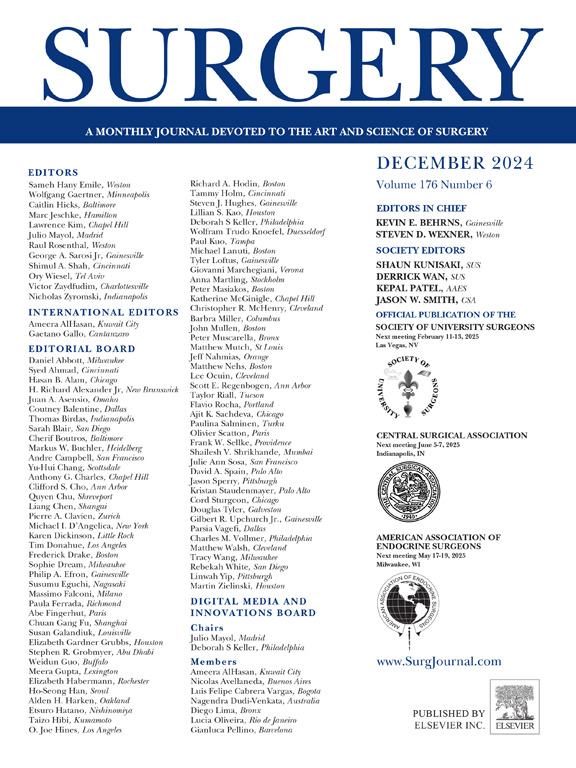术后呼吸衰竭电子质量测量的开发与验证
IF 2.7
2区 医学
Q1 SURGERY
引用次数: 0
摘要
术后,长时间机械通气或计划外插管(统称为“术后呼吸衰竭”)具有很高的发病率和死亡率,但目前医院自动检测这一并发症的能力有限。研究设计:我们在临床和质量专家的基础上开发了一种用于术后呼吸衰竭的电子临床质量测量方法。使用来自12家不同医院(包括2家常见电子病历供应商)的2022个结构化电子病历数据,我们回顾性评估了选择性住院期间手术后呼吸衰竭的标准。我们从每个中心抽取所有符合分母条件的病例,符合术后呼吸衰竭标准,以及不符合标准的子集。训练有素的护士文摘员使用标准仪器审查医疗记录。我们评估了该措施的正负预测值(95%置信区间),以及其风险模型的判别和校准。结果在95条被标记的记录和310条未标记分母合格的记录中,术后呼吸衰竭电子临床质量测量分子标准的阳性预测值为88.7%(95%置信区间,80.6 ~ 94.2%),阴性预测值为99.7%(95%置信区间,98.2 ~ 100%)。假阳性结果经常涉及容易纠正的呼吸治疗师文件错误。各医院术后呼吸衰竭的风险调整率从0.0至16.8/1,000住院患者不等。该风险模型包括8项合并症、6项实验室检查和美国麻醉医师协会的身体状态分类,c统计量为0.91。结论术后呼吸衰竭可通过易于获取、结构化的电子病历数据进行有效测量。术后呼吸衰竭电子临床质量测量将不依赖于行政索赔数据或由训练有素的抽象人员收集,为选择性围手术期护理的质量改进提供了潜在的信息。本文章由计算机程序翻译,如有差异,请以英文原文为准。

Development and validation of an electronic quality measure for postoperative respiratory failure
Background
Postoperatively, prolonged mechanical ventilation or unplanned intubation—collectively, “postoperative respiratory failure”—has high morbidity and mortality risk, but hospitals' automated ability to detect this complication is currently limited.
Study Design
We developed an electronic clinical quality measure for postoperative respiratory failure on the basis of input from clinical and quality experts. Using 2022 structured electronic health record data from 12 diverse hospitals encompassing 2 common electronic health record vendors, we retrospectively evaluated criteria for postoperative respiratory failure after an operation during an elective hospitalization. We sampled all denominator-eligible cases meeting postoperative respiratory failure criteria, and a subset that did not, from each center. Trained nurse abstractors reviewed medical records using a standard instrument. We assessed the positive and negative predictive value of the measure (with 95% confidence intervals), and the discrimination and calibration of its risk model.
Results
Among 95 records flagged by the measure and 310 denominator-eligible records not flagged, the postoperative respiratory failure electronic clinical quality measure numerator criteria had a positive predictive value of 88.7% (95% confidence intervals, 80.6–94.2%) and negative predictive value of 99.7% (95% confidence intervals, 98.2–100%). False-positive results frequently involved easily correctible respiratory therapist documentation errors. Risk-adjusted rates of postoperative respiratory failure across hospitals ranged from 0.0 to 16.8/1,000 hospitalizations. The risk model, which included 8 comorbidities, 6 laboratory tests, and American Society of Anesthesiologists physical status classification, had a c-statistic of 0.91.
Conclusion
Postoperative respiratory failure can be measured with high validity from readily available, structured electronic health record data. A postoperative respiratory failure electronic clinical quality measure would not be dependent on administrative claims data or collection by trained abstractors, offering the potential to inform quality improvement in elective perioperative care.
求助全文
通过发布文献求助,成功后即可免费获取论文全文。
去求助
来源期刊

Surgery
医学-外科
CiteScore
5.40
自引率
5.30%
发文量
687
审稿时长
64 days
期刊介绍:
For 66 years, Surgery has published practical, authoritative information about procedures, clinical advances, and major trends shaping general surgery. Each issue features original scientific contributions and clinical reports. Peer-reviewed articles cover topics in oncology, trauma, gastrointestinal, vascular, and transplantation surgery. The journal also publishes papers from the meetings of its sponsoring societies, the Society of University Surgeons, the Central Surgical Association, and the American Association of Endocrine Surgeons.
 求助内容:
求助内容: 应助结果提醒方式:
应助结果提醒方式:


